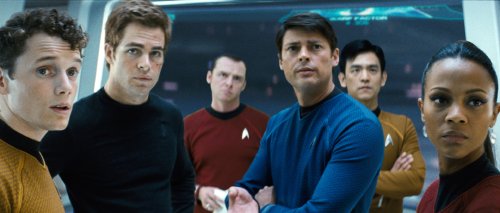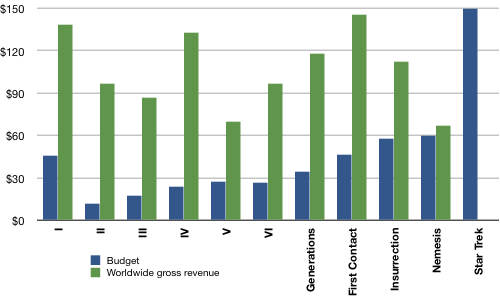Thoughts on the new Star Trek

The new Star Trek movie was outstanding, exciting and tremendous fun to watch, unlike too many of its predecessors, which were frequently earnest, flat and mediocre, if not outright calcified. “The near-universal enthusiasm for Abrams’ film,” says Slate’s Dana Stevens, “may partly spring from sheer relief that it isn’t awful.”
John Scalzi’s impression of the movie was that it was “big and pretty and noisy and didn’t look like a TV episode blown up to movie size, which was what sunk the series in the first place. No one wants to pay movie ticket prices for TV.”
After Star Trek: The Motion Picture’s production costs ballooned to $46 million (to Paramount’s dismay), Star Trek movies were produced more or less on the cheap; Star Trek II cost only about $11 or 12 million to make, and was produced by Paramount’s television unit. No wonder subsequent films felt so much like inflated TV episodes: I thought, for example, that Star Trek: Insurrection ($58 million budget) would have compared favourably with several of TNG’s two-part episodes (which would have cost maybe $4 million), but as a feature film it lacked grandeur and gravitas.
Star Trek movies were, until now, cheap: modestly budgeted movies that could make money on modest box office. Have a look at the numbers (in millions of dollars):

The new Star Trek is not a cheap movie: at $150 million, its budget is two and a half times that of its immediate predecessor, Star Trek: Nemesis, which was, itself, the most expensive Star Trek to date (and the biggest bomb, to boot). The new Star Trek also cost as much as the entire worldwide gross for the best-performing Star Trek — First Contact. All by itself, it cost only a few million less than the first six movies combined. All figures in unadjusted-for-inflation dollars, but the point remains: at last, a Star Trek with a real budget. This is what happens when Star Trek gets some serious resources put behind it.
This is also the first Star Trek with some consequences — all the more remarkable in a movie with a time-travel plot. If you know your Star Trek, you know how it is: every seriously bad thing that happens can be undone. If it’s not Spock being brought back from the dead by some Vulcan handwaving, it’s going back in time to fix whatever it is that went wrong. Ironically, some of the best (or at least best-reviewed) examples of Star Trek — from “City on the Edge of Forever” to Star Trek IV to First Contact — do this very thing. The lesson of Star Trek, to date, is that there is never any such thing as a no-win scenario.
When a fictional universe goes too many times to a deus ex machina — whether it’s time travel or Vulcan mysticism or technobabble word salad — that undoes everything awful, you lose all semblance of narrative tension or jeopardy. Everything becomes too easy; everything becomes too dull. That, in a nutshell, is what happened to Star Trek, where even the most drastic examples of loss were severely tempered: cast members would sometimes be killed, but could be resurrected in some form or other, like Spock or Dax or Data; family members could be killed, but in a fashion that spoke to their unimportance; ships could be destroyed, but you knew that the crew, unchanged, unpromoted and un-reassigned, would be sitting on a new/better ship before too long.
Remarkably, thought the first instinct of any writing team on any of the Star Trek TV series would have been to resolve the plot problem this movie presents by sending the Enterprise back in time to prevent it from happening in the first place, the new Star Trek doesn’t do this. It turns Star Trek’s upside-down lesson of the Kobayashi Maru right-side up again. It presents loss, and forces the characters to deal with that loss. And that makes for a much better story.
In sum: this is Star Trek that doesn’t hold back, whether in terms of cost or in terms of content.